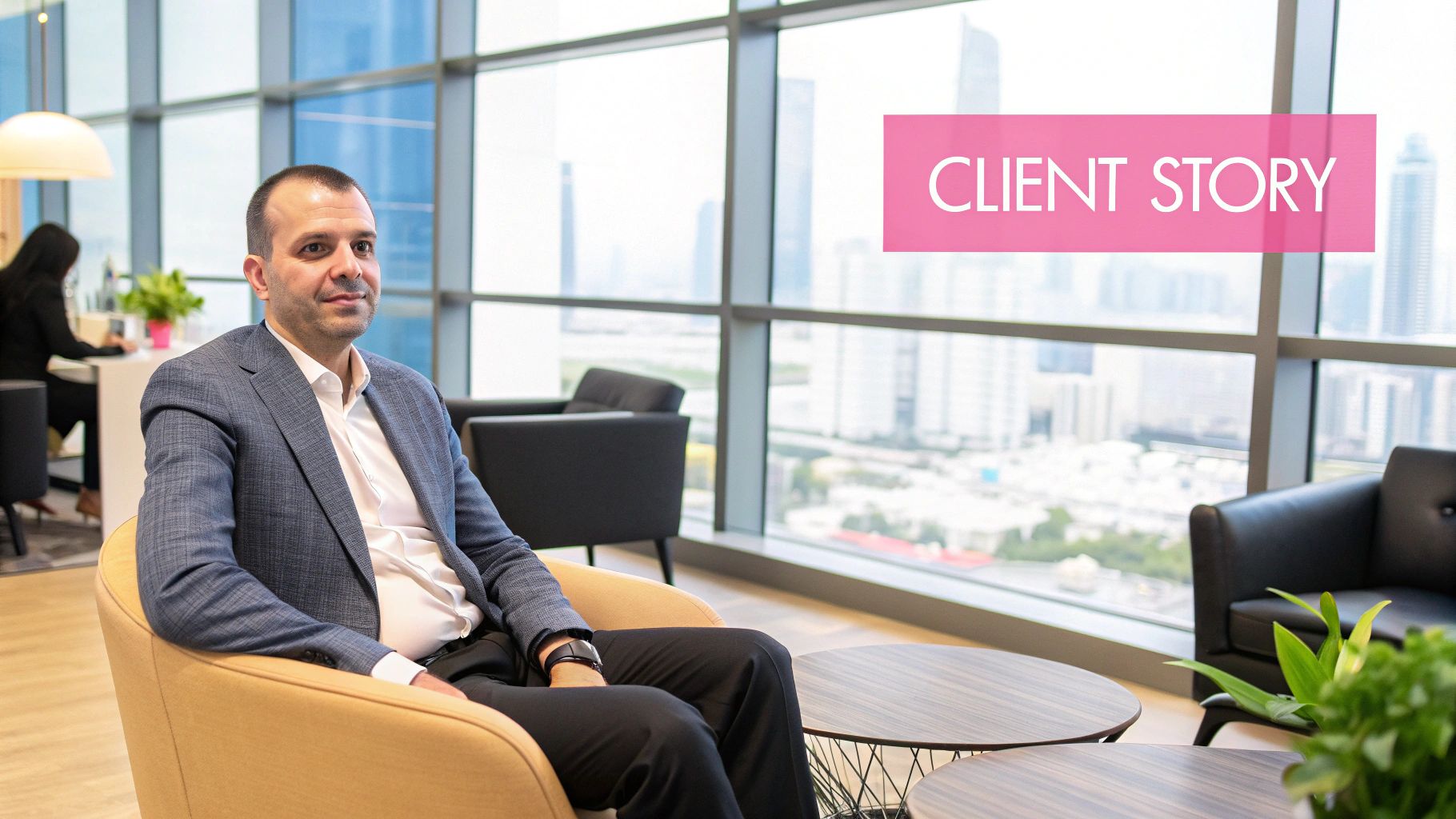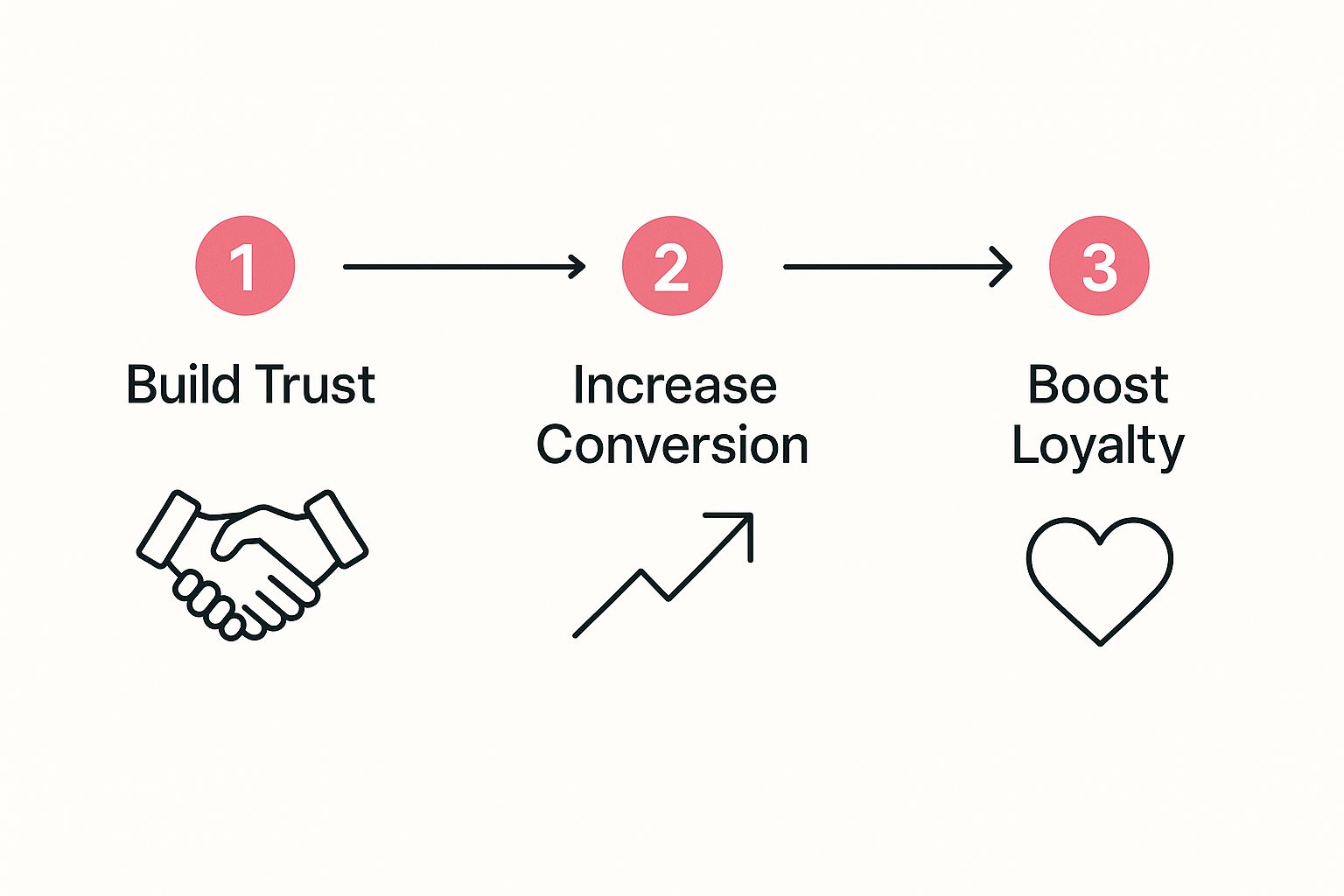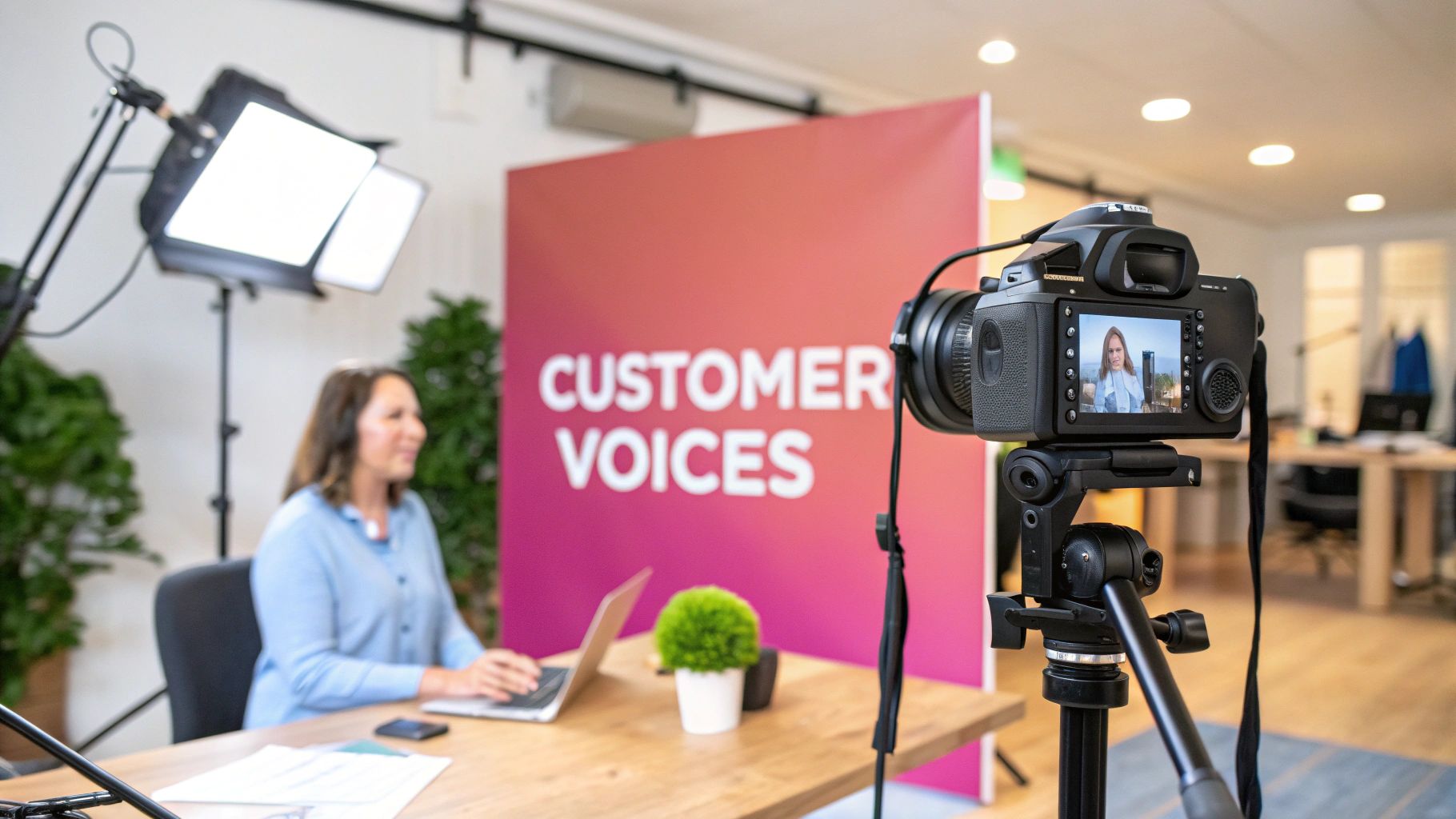Table of contents
At its core, a customer testimonial video is pretty simple: it’s a real client sharing their honest experience with your product or service. But don’t let that simplicity fool you. It’s one of the most powerful forms of social proof out there.
Why? Because it lets potential buyers see and hear authentic success stories. This builds trust and credibility in a way that a written review just can't match. These videos literally transform your happy customers into relatable, passionate advocates for your brand.
The Power of Authentic Customer Stories

Let's get real for a moment. In a world absolutely saturated with marketing messages, genuine stories are what cut through the noise. When a prospect sees a real person—not a polished actor—sharing a legitimate success story, it creates an instant emotional connection.
This isn't just a hunch; it's rooted in basic psychology. We're wired to trust other people. Seeing someone's facial expressions and hearing the sincerity in their voice makes their endorsement feel far more believable. It's the digital equivalent of a good friend giving you a recommendation you know you can count on.
Building Trust and Overcoming Scepticism
Every single person considering your business comes with a healthy dose of scepticism and a list of silent objections. They’re thinking, "Will this really work for me?" or "Can I actually trust this company?" A well-crafted video testimonial tackles these questions head-on, often before they're even consciously asked.
A truly powerful testimonial doesn't just rattle off features. It tells a story of transformation. It shows the journey from a nagging problem to a real solution, making the customer the hero and your business their trusted guide.
This storytelling approach is incredibly effective. In Australia, for instance, 72% of customers say they trust brands more when they see positive video testimonials. It's a clear signal of how potent these stories are for boosting your brand’s credibility.
Below is a quick look at the core benefits you can expect from integrating customer testimonial videos into your strategy.
Core Benefits of Customer Testimonial Videos
These benefits aren't just theoretical; they translate into tangible growth and a stronger brand reputation.
Accelerating the Sales Cycle
One of the biggest perks of a strong customer testimonial video is its ability to shorten the sales cycle. By addressing common concerns and showing proven results, these videos give prospects the confidence they need to make a purchase decision much faster.
Instead of your sales team having to build the entire case from scratch, you have an army of happy customers doing the heavy lifting for you.
The impact ripples across your business:
- Marketing: Embed them on landing pages, use them in email campaigns, and share them on social media to drive up conversion rates.
- Sales: Your team can send specific testimonials to prospects facing similar challenges, offering direct and highly relevant social proof.
- Branding: Using testimonials consistently helps build a brand image that’s centred on customer success and reliability.
If you want to go even deeper into showcasing customer success, learning how to create compelling video case studies offers some fantastic insights that tie in perfectly here.
Ultimately, investing in customer testimonial videos isn't just a marketing expense. It's a direct investment in trust, credibility, and sustainable growth.
Planning Your Testimonial for Success
You know, a truly powerful customer testimonial video isn't born from fancy camera work or slick production. It’s actually built on something far more fundamental: careful, thoughtful planning. Before you even think about hitting record, the most critical work happens behind the scenes.
This is where you shape the story. It’s where you ensure the final video connects and resonates deeply with the people you’re trying to reach. Get this part right, and the rest just falls into place.
Finding and Reaching Out to Your Ideal Advocate
First things first, you need to find the right person. This isn't just about finding a happy client; you're looking for a hero. You need someone whose journey mirrors that of your ideal buyer.
Think about customers who have seen specific, impressive results—the kind of results that directly solve the biggest headaches your prospects are dealing with right now. Those are your stars.
Once you’ve got a shortlist, it's time to reach out. This is a delicate step. Your goal is to make your customer feel valued and celebrated, not like you're just using them for a marketing task. Whatever you do, avoid those generic, automated requests. They just don't work.
A personal, friendly email is almost always the best way to go. Explain why you thought of them specifically. Mention their unique success and how their story could genuinely inspire others in a similar spot. Frame it as an opportunity to showcase their achievements, with your brand playing a supporting role.
Your approach should be one of gratitude and partnership. The best testimonials come from customers who are genuinely excited to share their story, and that excitement starts with how you ask.
Getting this outreach right is so important. To make sure you're on the right track, it's worth knowing the common pitfalls. You can learn more about the 7 common mistakes when asking for testimonials to make sure your request is both effective and respectful.
Crafting Questions That Encourage Storytelling
Okay, so your customer is on board. Awesome! The final piece of the planning puzzle is to map out your questions. The main goal here is to sidestep simple "yes" or "no" answers. You want to encourage real, authentic storytelling. The magic of a great testimonial video is in its unscripted, emotional, and genuine responses.
So, instead of a closed question like, "Are you happy with our service?", which will just get you a "yes," try a more open-ended approach.
- "Can you describe what life was like before you found our solution?"
- "What was the specific moment you realised this was really working for you?"
- "If you were to recommend us to a friend, what would you tell them?"
Questions like these invite your customer to reflect on their whole journey—the problem they had, their search for a solution, and the ultimate transformation. It’s this narrative structure that feels compelling and, most importantly, believable.
This whole process has a ripple effect that ultimately strengthens your entire business.

As you can see, the path from building trust to boosting loyalty shows how one well-planned testimonial becomes a powerful asset. It's something that delivers long-term value. By setting the stage correctly from the very beginning, you make sure the filming process is simply about capturing the incredible story you've already helped uncover.
Capturing Professional Footage with Any Camera

Here’s some good news you might not expect: you don't need a Hollywood-sized budget or a full camera crew to create a fantastic customer testimonial video. The camera in today's smartphones is nothing short of incredible. With just a few simple techniques, you can capture footage that looks clean, professional, and completely believable.
Let's be clear—the goal isn't cinematic perfection. It's authenticity. A genuine, well-lit video will always connect with viewers more than a shaky, poorly-lit one, no matter what camera you use. So, let’s walk through the key things you need to get right.
Framing and Composition Basics
How you frame your shot is the first thing that signals quality to a viewer. It all starts with finding a location that makes sense for the story. If your customer is a car detailer, filming in their organised garage adds instant context. A mortgage broker? Their modern office would be the perfect backdrop.
Once you’ve picked your spot, keep these simple rules in mind:
- Rule of Thirds: Picture a tic-tac-toe grid over your screen. Instead of placing your customer dead centre, position them along one of the vertical lines. It just creates a more dynamic and visually interesting shot.
- Clean Background: Make sure the background is tidy and free of clutter. A messy desk or a distracting poster can pull focus away from your customer and their important story.
- Steady Camera: Nothing screams "amateur" quite like shaky footage. A simple tripod for your phone or camera is a must. Even basic accessories can dramatically lift the quality of your video. Consider specialised equipment like a content magmount to help stabilize and position your camera for professional-looking footage.
Getting Crisp Audio and Flattering Light
You can have the most beautiful footage in the world, but poor audio will ruin it. A phone's built-in microphone is designed to pick up sound from all directions, which means it will catch every distracting background noise. A cheap lavalier (or lapel) microphone that clips onto your customer’s shirt is a game-changing investment. It isolates their voice, making them sound crisp and clear.
Lighting is just as crucial. But again, you don't need a complex, expensive setup.
The best and cheapest light source you can find is a large window. Position your customer so they are facing the window, letting that soft, natural light illuminate their face. Whatever you do, don't film with a bright window behind them—they'll turn into a dark, unwatchable silhouette.
This one simple tweak can make a massive difference in how professional your final testimonial video looks.
Conducting the Interview and Gathering B-Roll
Your number one job is to make your customer feel comfortable. Before you even think about pressing record, start with some casual conversation. Remind them there are no wrong answers; you're just there to listen to their story in their own words.
When the interview starts, be an active listener. Nod and smile to show you're engaged, but try to avoid making little verbal cues like "uh-huh" or "yeah." These can be a real headache to edit out later.
After the main interview is done, don't pack up just yet. You need to capture B-roll footage. This is all the extra, supplemental footage that adds visual interest and helps tell the story.
Think about capturing things like:
- Shots of the customer using or interacting with your product.
- Close-ups of their hands gesturing or their face as they reflect on a point.
- Wider shots of their business environment—their office, workshop, or storefront.
This B-roll is what you'll use in the edit to cut away from the main interview, making the final video much more dynamic and engaging. This is especially vital in the Australian market, where video now makes up a massive 64% of all digital content consumed. With Aussies keen to see more video from brands, a visually rich testimonial is your best bet for grabbing and holding their attention. You can discover more about Australian content consumption trends on eloquent.com.au.
Editing Your Footage into a Compelling Narrative
Alright, you've got all your raw footage in the can. Now for the fun part. This is where you get to put on your storyteller hat and transform a bunch of separate clips into a genuinely persuasive and professional-looking customer testimonial.
Don't get bogged down by the technical side of things. At its heart, editing is about masterful storytelling. Your one and only job here is to shape a clear, compelling narrative that connects with your audience on an emotional level.
The most powerful testimonials almost always follow a classic story arc. You start by introducing your customer and the specific, frustrating problem they were dealing with. Then, you introduce your product or service as the hero of the story—the solution that helped them smash that challenge. The story wraps up by celebrating their success and showing the real, positive change they've experienced.
Building Your Story with Soundbites and B-Roll
Your first mission in the editing suite is to go through every second of your interview footage. You're hunting for gold—those powerful soundbites. These are the concise, emotionally-charged statements that perfectly sum up the customer's journey. These gems will be the spine of your video's narrative.
Once you start arranging these key quotes into a logical sequence (problem, solution, result), it's time to layer in your B-roll footage. This is what breathes visual life into the story. For example, if your customer is talking about how clunky their old workflow was, you can cut to a shot of them looking stressed at their desk or even a quick shot of the awkward tool they used to use.
This is a non-negotiable step. It's what keeps your video from becoming a boring "talking head" interview. Instead, B-roll adds crucial context and visual flair, making the whole thing far more dynamic and watchable. If you're looking for a bit of inspiration on how to piece it all together, checking out a detailed guide on creating a powerful client testimonial video can offer some fantastic real-world examples.
Here's a pro tip: B-roll isn't just filler. It must always support what's being said. When a customer talks about the amazing results, show them enjoying those results. This visual proof makes their story infinitely more believable and impactful.
Adding Professional Polish
With the core story locked in, it’s time for the finishing touches that will take your video from 'good' to 'great'. These are the little things that scream professionalism and make your final cut feel polished and trustworthy.
Music Selection: The right background music can completely change the video's emotional tone. Find an instrumental track that matches the story’s vibe—maybe something that starts off a bit thoughtful or tense and then builds to an uplifting, inspiring finish.
Branding Elements: Don't let viewers forget who you are. A subtle logo in the corner throughout the video is standard practice, as is a branded end screen with your website. It reinforces your brand without feeling like a hard sell.
Text and Graphics: Use clean, simple text overlays to introduce your customer by name and company. You can also use them to highlight a particularly juicy quote or a key statistic they mention. This helps viewers lock in the most important bits of information.
Accessibility and a Clear Call to Action
To get the most mileage out of your video, there are two final, crucial elements. First, you absolutely must add captions. A massive number of people watch videos on social media with the sound off, and captions are the only way to make sure your message lands. They also make your content accessible to viewers who are deaf or hard of hearing.
And finally, every great testimonial needs a strong call-to-action (CTA). What's the next step for the viewer? Don't just let the video end. Give them a clear, direct instruction. A simple text overlay paired with a verbal cue like, "Visit YourWebsite.com.au to Learn More" or "Schedule Your Free Consultation Today" tells them exactly what to do next.
How to Get Your Testimonial Video Seen

Just take a look at the YouTube homepage. It's a perfect snapshot of how central video has become to our online lives. But these platforms aren't just for cat videos and music; they're powerful search engines where your potential customers are actively looking for solutions and answers.
So, you've gone through the effort of creating a fantastic customer testimonial video. That’s a huge win, but the job isn't quite done. An incredible video that no one ever sees is a massive missed opportunity. Now it's time to put on your distribution hat and make sure that powerful story gets in front of the right people.
When you promote your testimonial effectively, you're building social proof at every single touchpoint of the buyer's journey. It's all about being strategic and placing this asset where it will do the most good—building trust and nudging people towards action.
Strategic Placements on Your Website
Your own website is the most valuable piece of digital real estate you own. This is where potential customers come to size you up, so you need to put your testimonials right where they can influence the decision-making process.
And I don't just mean tucking them away on a dedicated "Testimonials" page. That’s a decent start, but we can get much smarter about it.
- Homepage: Put your most compelling video front and centre on your homepage. It’s an instant credibility booster that humanises your brand for anyone visiting for the first time.
- Service or Product Pages: Embed relevant testimonials directly on the pages that detail what you sell. If a video has a customer raving about a specific service, that's precisely where it belongs.
- Key Landing Pages: Running a targeted ad campaign? A well-placed testimonial on the landing page can give your conversion rates a serious lift by offering immediate social proof.
The real trick is to anticipate a prospect's doubt and meet it head-on with authentic proof, right at the moment they're weighing up their options. When you place testimonials strategically, your website transforms into a far more persuasive and effective conversion machine.
Amplify Your Reach with Social Media and Email
Once your website is sorted, social media and email are your go-to channels for getting more eyes on your customer's story. YouTube, in particular, is a giant in Australia's digital scene. In 2024, it reached about 20.8 million Australian users, who spend hours on the platform. It's not just a social network; it's a must-have for your brand.
Think about creating a shorter, punchier cut of your video—maybe 30-60 seconds long—that’s perfect for platforms like Instagram, Facebook, and LinkedIn. This version should highlight the single most powerful quote or outcome. And always, always include a link back to the full video on your website.
Email marketing is another absolute powerhouse for this. Share the testimonial with your newsletter subscribers, framing it as a success story you're really proud of. It’s a great way to reinforce the value you bring and keep your brand top of mind. For a bit of inspiration, check out some great video testimonial examples from other brands to see how they package their stories.
Don't forget your sales team, either. These videos are incredibly potent tools for them. They can send specific testimonials to prospects who are sitting on the fence, offering up highly relevant proof from a peer. Sometimes, that personal touch is exactly what’s needed to get a deal across the line.
Got a few questions swirling around as you gear up to make your own testimonial videos? Don't worry, that's completely normal. Nailing down the answers to these common queries can make the whole process feel less daunting and set you up for success right from the start.
Let's dive into some of the things people ask most often.
One of the first hurdles is always length. How long should this thing be? While there's no single magic number, my experience shows that the sweet spot for a powerful testimonial video is somewhere between 60 and 90 seconds.
That gives you just enough runway to tell a complete and compelling story—you can touch on the customer's initial problem, introduce how you helped, and wrap up with their successful outcome, all without your viewer's attention starting to drift.
But for social media? Think shorter. Much shorter. Whipping up quick 15-30 second clips that highlight a single, punchy quote can be a brilliant way to stop the scroll and grab attention in a crowded feed.
What's the Deal with Paying Customers?
Another question that comes up a lot is about compensation. Should you pay customers for giving you a testimonial? The short answer is no—it's best to steer clear of direct payment. Why? Because it can completely tank the authenticity that makes these videos so convincing in the first place. A testimonial that feels like a paid ad can lose its credibility in a heartbeat.
Instead, the goal is to show genuine appreciation. Think about offering a thoughtful, non-cash thank you.
- A generous discount on their next purchase or service.
- A high-value gift card to a place they'd actually enjoy, like a popular local restaurant.
- Giving their business a shout-out and featuring their success story on your social media channels or in your newsletter.
At the end of the day, authentic enthusiasm will always be more persuasive than a paid endorsement.
The real magic of a great customer testimonial isn't in its polish, but its authenticity. A video that feels real, unscripted, and emotionally honest will always outperform a stiff, overly produced one. Your primary goal should be to capture your customer's genuine story in their own words, as their sincere excitement will connect most deeply with your audience.
Ready to make collecting genuine video testimonials easier than ever? Testimonial Donut streamlines the entire process, helping you capture and showcase authentic customer stories on autopilot. Start your journey at https://www.testimonialdonut.com.



